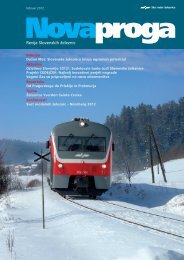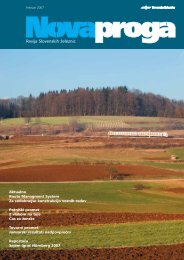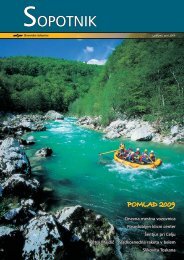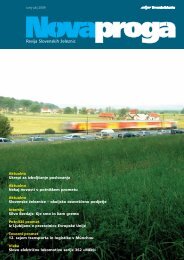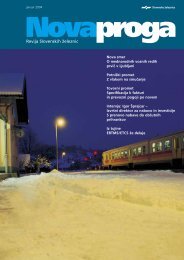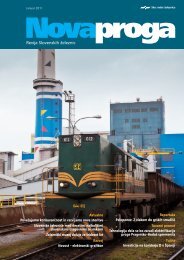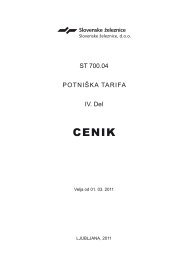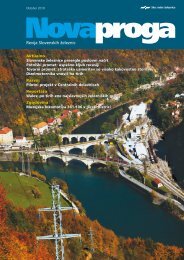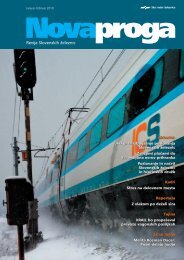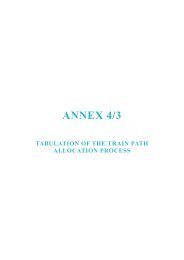Network Statement 2014 - Slovenske železnice
Network Statement 2014 - Slovenske železnice
Network Statement 2014 - Slovenske železnice
- No tags were found...
Create successful ePaper yourself
Turn your PDF publications into a flip-book with our unique Google optimized e-Paper software.
<strong>Slovenske</strong> železnice - Infrastruktura d.o.o. – <strong>Network</strong> <strong>Statement</strong> of the Republic of Slovenia <strong>2014</strong> – 9.12.2012 – 03.3.3.3. Radio Dispatch ConnectionsRadio dispatch connections (RDZ) have been developed especially for railroads, and theyallow uninterrupted telecommunication connection between the train (locomotive) and thedispatcher centre on certain sections of the train route. They present rational and necessaryinstruments for the railroad traffic management.Due to possibility of direct emergency call in both directions the radio dispatch connection isa supplement to the existing railway signalling and traffic control systems and increases thegeneral safety of the traffic. RDZ consists of: RDZ base stations, Radio dispatch centre, RDZ locomotive station.The RDZ system operates within the radio frequency ranges from 457,450 MHz to 458,300MHz and from 467,450 MHz to 468,300 MHz.The connection between the locomotive and the train route dispatcher is established by aselective call. Commands or messages are transferred in a coded digital or phonic form.Messages and orders may be sent by activating appropriate pre-programmed keys. Thereception of coded messages is optically and acoustically indicated on light fields, which aredesignated by anticipated symbols.The number of the train, which can be a six digit number, is used as a reference number.Since the selective call makes the line busy (blocked for the rest of the trains) for as long asthe information is being transferred. The speed of 600 Bauds is used for the transfer ofcoded messages. This makes the line busy for as little time as possible and is approximately100 milliseconds. If the message is not received by the receiver for whatever reason, theprocess is repeated automatically.In an emergency situation, the communication desk in the radio dispatcher station allows forsimultaneous calls of all the locomotives in a certain RD train route section. Likewise, it ispossible to make an emergency call from the locomotive to the radio dispatch stationdespite the busy line. The frequency diversity switches the locomotive receiver to thefrequency which has the strongest field at a given moment. After changing the radiodispatch section, the frequency has to be set up manually.On the train side, the radio dispatch system provides the connection with the public addresssystem, while on the radio dispatch station side it provides the connection with the railwaytelephone network and other communication systems.Each radio dispatch section represents a closed technical and technological unit whichcannot be interrupted by other sections. Junctions of RDZ systems are covered betweeneach other. The designations of junctions on the railroad consist of the mark RDZ K and thenumber of the radio channel.3.4. Traffic Restrictions3.4.1. Specialized InfrastructureFor timetable period 2013/<strong>2014</strong> the following lines are defined as specialised infrastructure: (Čakovec) – d.m. - Lendava, which do not have a direct connection with the homePAGE 32



